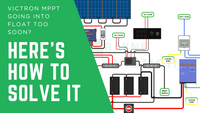Proper battery care is essential to get the best performance and longest life from your campervan battery. By following these guidelines, you'll ensure your battery stays in optimal condition, only failing from old age, manufacturing faults, or physical damage.
Unpacking
When unpacking your battery, always refer to the safety note included in the package. Remove the transport plugs (which could be red, yellow, grey, or black, depending on the manufacturer) before use. While most batteries arrive ready to use and do not need recharging, it's beneficial to charge the battery if it's voltage is below 12.4V before installation.
Venting
AGM batteries should be vented to the outside if they are stored in a habitable space, this is the responsibility of the installer and can be done either with a vent tube if your battery has a venting hole, or a battery box if it doesn't.
Battery Care
Checking the State of Charge
Use a voltmeter or multimeter to measure your battery's voltage. This will help you determine its state of charge:
- 100% (12.7V or higher): No action required.
- 75% (12.4V): No action required.
- 50% (12.1V): Battery needs recharging.
- 25% (11.6V): Full recharge required as soon as possible.
- 0% (10.5V): Fully discharged, recharge immediately.
Avoid fully discharging your battery, as it reduces capacity and lifespan. Recharge as soon as possible after use, irreversible damage can occur almost immediately when batteries are taken below 10.5V.
Cleaning
Clean your battery every few months to prevent dirt and corrosion. Use a solution of baking soda and water or an electrical contact cleaner with a wire brush. Ensure all residue is wiped off to avoid damage.
Storage
Avoid Storing in a Discharged State
Store a fully charged battery for up to 2-3 months without issues. However, storing a flat battery can cause irreparable damage due to sulphation. Sulphation occurs when the battery voltage falls below 12.4V, forming sulphur crystals on the lead plates and increasing electrical resistance. If caught early, a pulse charge function on a battery charger might help, but the battery will never regain full capacity.
Avoid Overcharging
Overcharging causes the battery to heat up, evaporating the electrolyte and damaging the plates. Faulty vehicle regulators or leaving a manual charger on continuously can lead to overcharging. Instead, perform regular charge and discharge cycles. For slow discharge batteries, do an equalisation charge every 30 to 90 days (15.5V for several hours) to remove sulphate from the plates. (this equalisation can be set in Victron smart MPPT solar controllers).
Usage
Avoid Deep Discharging
Repeated deep discharging severely impacts battery performance and lifespan. Whenever possible, recharge the battery before it becomes fully discharged to minimize performance loss.
By adhering to these care instructions, you'll ensure your campervan battery remains in top condition, maintaining its warranty and providing reliable performance.
Batteries which fail prematurely due to incorrect use and care are not covered under warranty.





